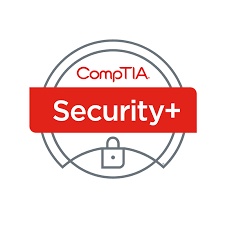$199.00
Our CompTIA CAQC-approved learning materials are tried and tested and have been used by training centers across the globe since the late 1990s.
The course includes the following key features:
- 35 hours of CompTIA CAQC-approved approved learning content
- 35 hours of Professor Messer integrated training videos
- 12 months access to online learning delivered through your web browser
- Dynamic practice exams with answers linked to relevant learning content and videos
In Stock
Description
Module 1 – Security Threats and Controls
- Security Controls • Why is Security Important? • Security Policy • Security Controls • Identification • Authentication • Authorization • Basic Authorization Policies • Accounting
- Threats and Attacks • Vulnerability, Threat, and Risk • Social Engineering • Phishing • Malware • Trojans and Spyware • Preventing Malware • Anti-Virus Software • Removing Malware
- Network Attacks • Network Fundamentals • Sniffers and Protocol Analyzers • ARP Attacks • IP Spoofing and Hijacking • Network Mappers and Port Scanners • Denial of Service Attacks
- Assessment Tools and Techniques • Vulnerability Assessments and Pentests • Security Assessment Techniques • Vulnerability Scanners • Honeypots and Honeynets
Module 2 – Cryptography and Access Control
- Cryptography Uses of Cryptography • Cryptographic Terminology and Ciphers • Encryption Technologies • Cryptographic Hash Functions • Symmetric Encryption • Asymmetric Encryption • Diffie-Hellman • ECC and Quantum Cryptography • Transport Encryption • Cryptographic Attacks • Steganography • Labs • Steganography
- Public Key Infrastructure • PKI and Certificates • Certificate Authorities • Implementing PKI • Creating Keys • Key Recovery Agents • Key Status and Revocation • PKI Trust Models • Cryptographic Standards • PGP / GPG • Labs • Configuring Certificate Services
- Password Authentication • LAN Manager / NTLM • Kerberos • PAP and CHAP • Password Protection • Password Attacks
- Strong Authentication • Token-based Authentication • Biometric Authentication • Common Access Card • Extensible Authentication Protocol • RADIUS and TACACS+ • Federation and Trusts
- Authorization and Account Management • Privilege Policies • Directory Services • Lightweight Directory Access Protocol • Windows Active Directory • Creating and Managing User Accounts • Managing Group Accounts • Account Policy Enforcement • User Rights, Permissions, and Access Reviews
Module 3 – Network Security
- Secure Network Design • Secure Network Topologies • Demilitarized Zones • Other Security Zones • Network Device Exploitation • Switches and VLANs • Switch Vulnerabilities and Exploits • Routers • Network Address Translation
- Security Appliances and Applications • Basic Firewalls • Stateful Firewalls • Proxies and Gateways • Implementing a Firewall or Gateway • Web and Email Security Gateways • Intrusion Detection Systems • IDS Analysis Engines • Monitoring System Logs
- Wireless Network Security • Wireless LANs • WEP and WPA • Wi-Fi Authentication • Additional Wi-Fi Security Settings • Wi-Fi Site Security
- VPN and Remote Access Security • Remote Access • Virtual Private Networks • IPSec • Remote Access Servers • Remote Administration Tools • Hardening Remote Access Infrastructure
- Network Application Security • Application Layer Security • DHCP Security • DNS Security • SNMP Security • Storage Area Network Security • IPv4 versus IPv6 • Telephony
Module 4 – Host, Data, and Application Security
- Host Security • Computer Hardening • Host Security Management Plan • OS Hardening • Patch Management • Endpoint Security • Network Access Control • Labs • Network Access Protection
- Data Security • Data Handling • Data Encryption • Data Loss Prevention • Backup Plans and Policies • Backup Execution and Frequency • Restoring Data and Verifying Backups • Data Wiping and Disposal
- Web Services Security • HyperText Transport Protocol • SSL / TLS • Web Servers • Load Balancers • File Transfer
- Web Application Security • Web Application Technologies • Web Application Databases • Web Application Exploits • Web Application Browser Exploits • Secure Web Application Design • Auditing Web Applications • Web Browser Security
- Virtualization and Cloud Security • Virtualization Technologies • Virtual Platform Applications • Virtualization Best Practices • Cloud Computing • Risks of Cloud Computing
Module 5 – Operational Security
- Site Security • Site Layout and Access • Gateways and Locks • Alarm Systems • Surveillance • Hardware Security • Environmental Controls • Hot and Cold Aisles • RFI / EMI • Fire Prevention and Suppression
- Mobile and Embedded Device Security • Static Environments • Mitigating Risk in Static Environments • Mobile Device Security • Mobile Device Management • BYOD Concerns • Mobile Application Security • Bluetooth and NFC
- Risk Management • Business Continuity Concepts • Risk Calculation • Risk Mitigation • Integration with Third Parties • Service Level Agreements • Change and Configuration Management
- Disaster Recovery • Disaster Recovery Planning • IT Contingency Planning • Clusters and Sites
- Incident Response and Forensics • Incident Response Procedures • Preparation • Detection, and Analysis • Containment • Eradication, and Recovery • Forensic Procedures • Collection of Evidence • Handling and Analyzing Evidence
- Security Policies and Training • Corporate Security Policy • Operational Policies • Privacy and Employee Policies • Standards and Best Practice • Security Policy Training and User Habits


Comments Closed
Comments for this post are now closed.